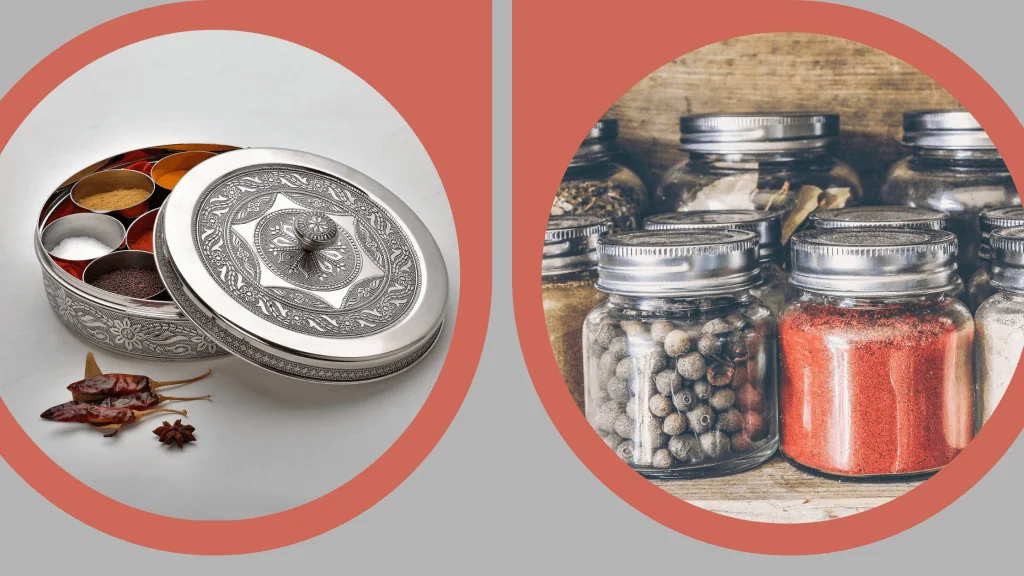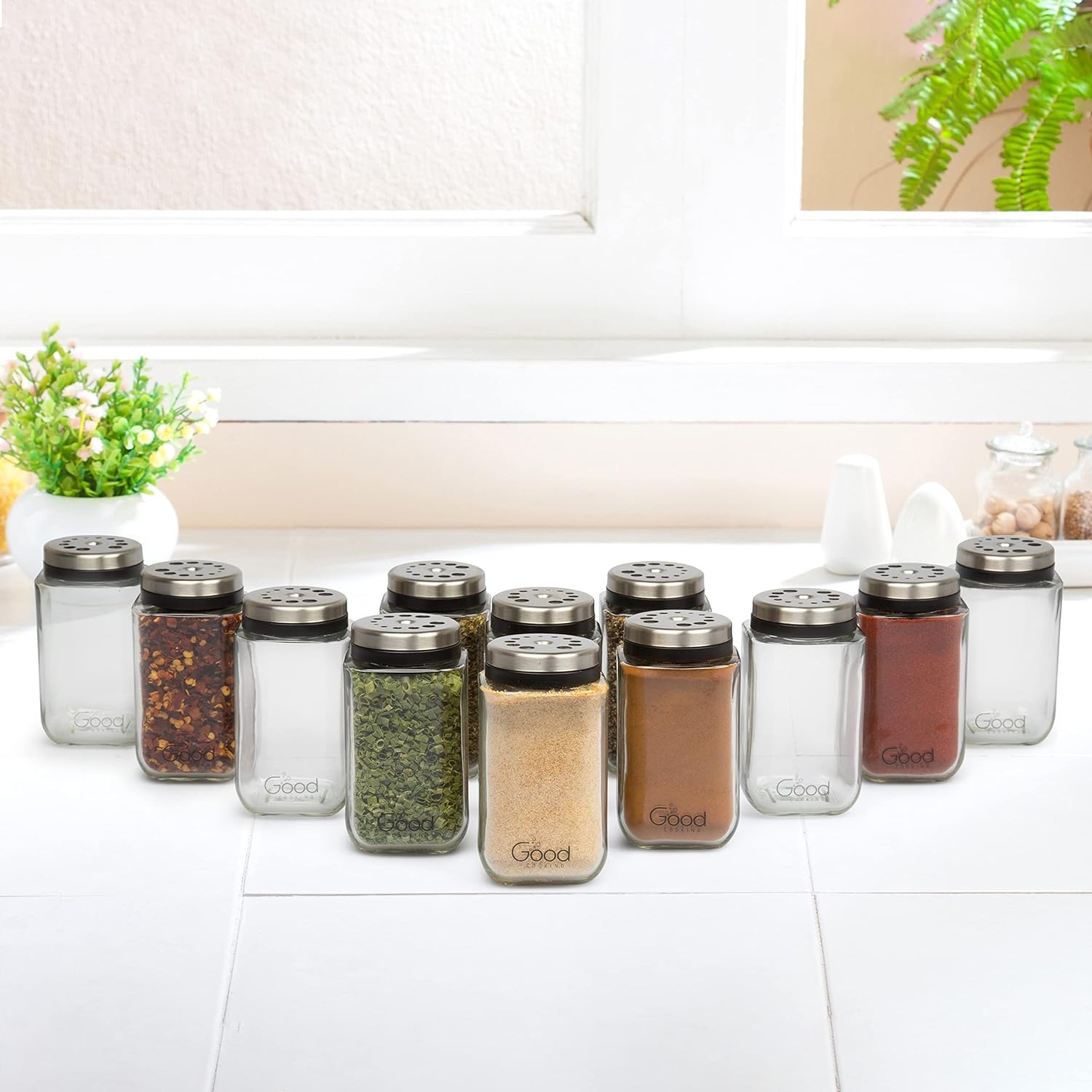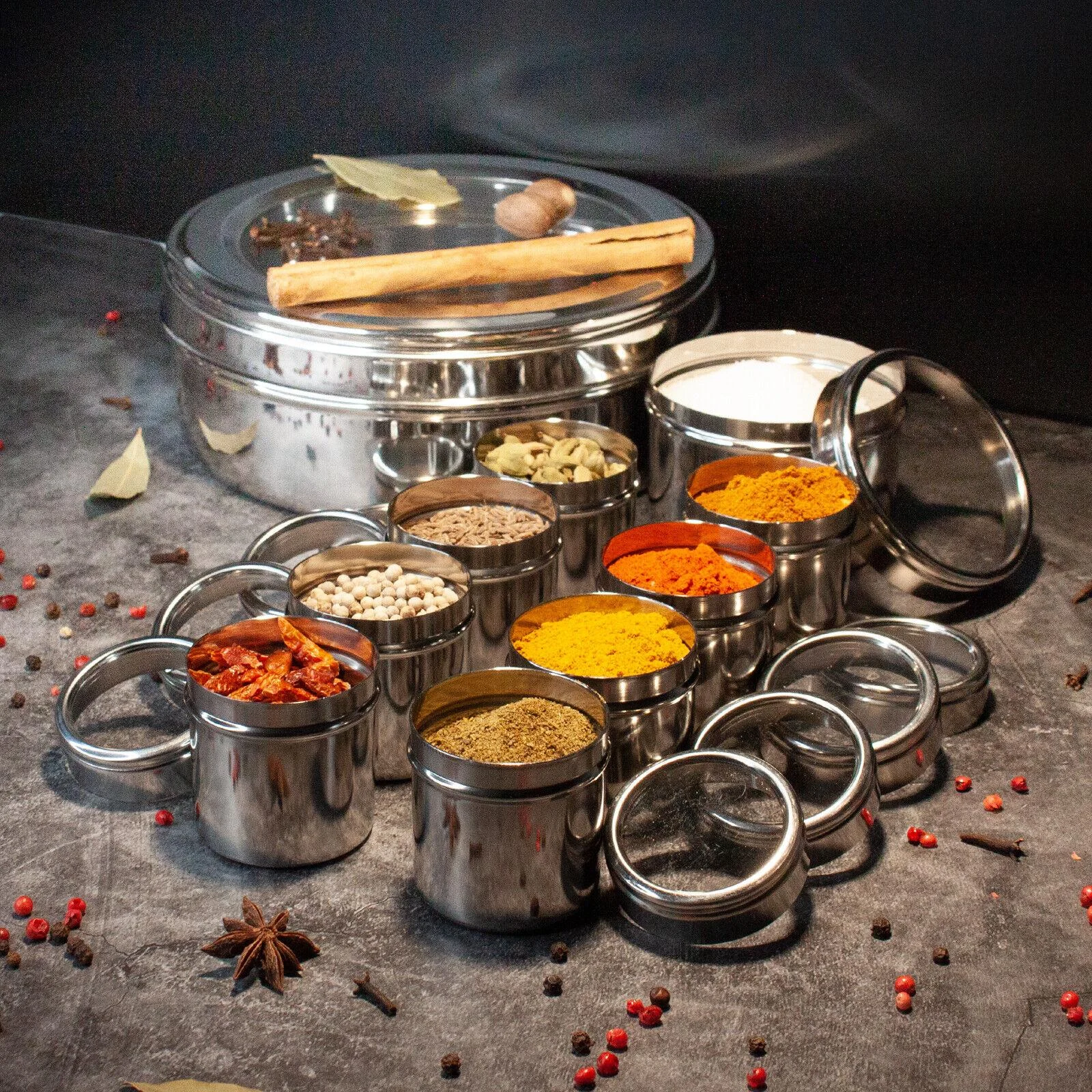Many of us buy spices in glass jars, making them a convenient default for storage. Others prefer the sleek, modern look of stainless steel containers. But beyond aesthetics and convenience, which material is functionally better at keeping your spices fresh? The answer lies in how well each material blocks light, seals out air, and resists environmental factors. Let’s explore the key differences between glass and stainless steel for spice storage.

Table of Contents
The Importance of Storing Spices Correctly
Getting the most flavor out of your spices starts with how you store them. Proper storage protects the essential oils that give spices their aroma and taste. When exposed to light, heat, or moisture, these oils break down, leading to a dull, flat flavor. In fact, studies suggest that spices stored poorly can lose up to half their potency in just six months.
How Poor Storage Affects Your Spices
Spices don’t exactly “go bad” quickly, but they do lose their power. Ground spices are particularly vulnerable, often fading within 6–12 months if left in a leaky container or a warm spot. Even sturdy whole spices, which can last for years under ideal conditions, will decline faster without protection. Heat and humidity are the biggest culprits, causing spices to clump and, in worst-case scenarios, promoting mold growth.
A Simple Guide to Better Spice Storage
The goal is simple: protect your spices from their enemies—air, light, heat, and moisture. The best way to do this is by using airtight containers. This single change can dramatically extend a spice’s shelf life.
When choosing a container, two popular options are glass jars and stainless steel tins. Glass is non-porous, doesn’t absorb odors, and lets you see the contents at a glance. Stainless steel, on the other hand, is excellent at blocking all light and is very durable. The key is to then store these containers in a cool, dark, and dry place—a cupboard away from the stove or oven is perfect.
Final Thoughts
Taking a little care with your spice storage is a worthwhile habit. By choosing airtight containers, keeping them in a suitable spot, and buying in smaller quantities you’ll actually use, you ensure your dishes are always full of vibrant flavor. It’s a simple step that makes a noticeable difference in your cooking.
Why Glass Jars Are a Top Choice for Spice Storage
When it comes to keeping spices fresh and flavorful, the container matters. While different materials have their merits, glass stands out for its combination of practicality, safety, and clarity. Here’s a closer look at what makes glass jars an excellent option for any kitchen.

Superior Freshness Preservation
Glass containers typically offer an excellent airtight seal, which is crucial for locking out oxygen—one of the main factors that causes spices to lose their aroma and flavor. Because glass is non-porous, it also effectively blocks moisture, helping to prevent clumping and mold. This makes it suitable for everything from finely ground cumin to oil-rich spices like paprika.
Pure Flavor, No Transfer
One of the key benefits of glass is that it’s inert and non-reactive. That means it won’t absorb odors or flavors from strong spices, so garlic powder stays garlicky and cinnamon stays sweet—with no crossover. In addition, unlike some plastics, glass doesn’t introduce chemicals or microplastics into your spices, even when stored near heat sources.
Easy to Use & Organize
The transparency of glass is a major advantage in a busy kitchen. With a quick glance, you can identify the spice you need without opening every jar. This not only saves time but also minimizes exposure to air, which helps maintain freshness longer. Many cooks also find it easier to track inventory and avoid buying duplicates when they can see what’s left in the jar.
In Summary
For those prioritizing flavor purity, ease of use, and sustainable storage, glass offers a reliable and attractive solution. Its ability to preserve spice quality—while allowing quick visual access—makes it a favorite among home cooks and professional chefs alike.
Durability: Glass vs. Stainless Steel Spice Containers
When choosing containers for a spice cabinet, durability is a key factor. It’s not just about surviving an occasional drop—it’s about how well the material holds up to daily use, cleaning, and kitchen environments. Here’s a practical look at how glass and stainless steel compare in terms of toughness and longevity.
Stainless Steel: The Durable Workhorse
Stainless steel is widely regarded as the more resilient option. These containers are impact-resistant, meaning they can withstand being knocked over or dropped without denting or breaking. They are also highly resistant to scratches, corrosion, and rust, which helps them maintain their appearance even with frequent handling and washing.
Glass: Strong but Less Forgiving
High-quality glass jars, especially those made from tempered or borosilicate glass, are more durable than they might appear. They resist scratches and stains effectively and won’t degrade over time. However, their main weakness is brittleness—a hard impact on a hard surface can lead to chipping or shattering.
One functional advantage of glass is its transparency, allowing users to quickly identify spices without opening the container.
Which Should You Choose?
The decision often comes down to lifestyle and usage:
For maximum durability: If you prioritize toughness, drop-resistance, and long-term heavy use, stainless steel is the clear winner.
For lighter, more organized use: If your spice jars stay mostly in a cabinet or on a stable rack, and you value being able to see contents at a glance, glass is an excellent and aesthetically pleasing option.
Both materials are reusable, easy to clean, and environmentally friendly. But when it comes to pure physical endurance, stainless steel has the edge.
Light Protection for Spices: Glass vs. Stainless Steel
When it comes to preserving spice quality, light is a silent but significant threat. Sunlight and even constant exposure to bright kitchen lights can degrade the volatile oils that give spices their aroma and flavor. The choice between glass and stainless steel containers plays a key role in blocking out this damage.
Why Light Protection is Non-Negotiable
Light, especially direct sunlight, speeds up the oxidation process. This breaks down the essential compounds in spices, leading to faded color, weakened aroma, and a noticeably duller taste. Without proper protection, spices can lose their potency in a matter of months, long before their expected shelf life is up.
Stainless Steel: Maximum Light Blocking
Stainless steel containers offer complete opacity, making them the most effective option for light protection. By blocking 100% of light, they create a dark, stable environment that helps spices—both whole and ground—retain their strength and character for much longer. This makes them an ideal choice for spices stored on open countertops or in naturally bright kitchens.
Glass: The Need for Strategic Storage
The main appeal of glass is its transparency, which allows for easy identification of spices. However, this also means clear glass offers little defense against light. Storing clear glass jars in direct light will quickly compromise the quality of their contents.
While amber or cobalt-tinted glass jars provide some protection by filtering out certain light wavelengths, they are not as effective as fully opaque materials. For those who prefer glass, the simplest solution is to store the jars inside a closed cupboard or a dark drawer, away from all light sources.
A universal rule: Regardless of container material, keeping spices in a cool, dark place is one of the easiest and most effective ways to extend their freshness.

Health & Safety: Glass vs. Stainless Steel Spice Containers
When it comes to storing spices, health and safety are just as important as preserving flavor. Both glass and stainless steel are excellent, non-toxic choices, but they each have distinct characteristics that may suit different needs and preferences.
The Case for Glass: Purity and Transparency
Glass is widely appreciated for its safety profile. Being chemically inert, it won’t react with spices—even acidic ones—ensuring no unwanted substances leach into your food. It’s naturally free from chemicals like BPA and phthalates, which can be a concern with some plastics.
A key advantage of glass is its transparency. You can easily inspect spices for quality, spotting any signs of moisture, clumping, or spoilage without opening the jar. Glass is also non-porous, meaning it won’t absorb strong odors or stains from spices like turmeric or curry powder, and it’s generally easy to clean, often dishwasher-safe.
The Case for Stainless Steel: Durability and Full Protection
Stainless steel stands out for its exceptional durability. It’s virtually unbreakable under normal kitchen use, eliminating the risk of shattering and making it a safer option in busy households or around children.
From a health standpoint, high-quality food-grade stainless steel (such as types 304 or 316) is non-reactive and resistant to corrosion, providing a safe environment for spices. Like glass, it doesn’t retain odors or stains and is straightforward to clean.
Both materials are used in medical and food-grade environments for their safety and hygiene. Your decision ultimately depends on whether you value the transparent purity of glass or the rugged, full-protection durability of steel.
Cost Comparison: Glass vs. Stainless Steel Spice Containers
For many home cooks, budget is a key factor when organizing a spice collection. When comparing container materials, glass and stainless steel sit at different price points, each offering distinct value.
Initial Cost: Glass is More Budget-Friendly
Generally, glass spice jars are the more affordable option. Simple glass jars can start as low as under $1 each when bought in multi-packs from retailers like IKEA or Target. Even larger or more stylish glass containers typically range from $2 to $5 per jar. This low entry cost makes glass an accessible choice for anyone looking to organize their spices without a significant upfront investment.
Stainless Steel: A Higher Initial Investment
Stainless steel containers command a higher price. Individual jars often range from $3 to $8, with premium sets sometimes costing over $20 for just four to six jars. This higher price reflects the material’s durability, opaque light-blocking properties, and often a more modern aesthetic.
Glass, though more fragile, remains a cost-effective and excellent option for low-traffic home kitchens. Its transparency is a functional benefit, and it is equally reusable and recyclable.
Environmental Impact: Glass vs. Stainless Steel Spice Containers
When choosing containers for spice storage, many people consider not only functionality and cost but also environmental impact. Both glass and stainless steel are far more sustainable than plastic, but they each have distinct ecological footprints worth understanding.
Recyclability and Material Lifecycle
Glass is 100% recyclable and can be melted down and remade into new jars indefinitely without losing purity or quality. This creates a true closed-loop system, reducing the need for new raw materials. In practice, recycling rates vary—some countries recycle over 90% of glass, while others are lower—but the potential for reuse remains high.
Stainless steel is also highly recyclable. A significant percentage of new stainless steel is made from recycled material, and like glass, it can be recycled repeatedly without degrading. Its durability means that even if not recycled immediately, a well-made steel container can serve for decades.
Durability and Long-Term Use
From a sustainability perspective, longevity matters. Stainless steel excels in durability—it’s shatterproof, resistant to corrosion, and unlikely to need replacement, making it an excellent choice for reducing waste over time.
Glass, while more fragile, can also last for years with careful handling. Stronger types like borosilicate glass offer better resistance to thermal shock. And since glass doesn’t stain or absorb odors, it can be reused countless times for various purposes beyond spice storage.
Which Is the Greener Choice?
There’s no definitive winner—each material has merits:
Glass is ideal for those who prioritize endless recyclability and non-toxicity.
Stainless steel may be preferable where durability and unbreakability are key, especially in households with children or in high-use kitchens.
What’s clear is that both are responsible alternatives to single-use plastic. By choosing either glass or stainless steel—and reusing or recycling them thoughtfully—you contribute to a more circular and less wasteful kitchen.

Conclusion: Glass or Stainless Steel for Your Spices?
When it comes to choosing between glass and stainless steel spice containers, there’s no one-size-fits-all answer. Both offer distinct advantages, and the best choice often depends on individual kitchen habits, storage conditions, and personal priorities.
A Quick Recap of Key Strengths
Glass containers excel in visibility and aesthetics. Their transparency allows for easy identification of spices, helping with organization and quick freshness checks. Glass is non-porous, chemically inert, and won’t absorb odors or stains, making it a safe and hygienic option. It’s generally more budget-friendly and fully recyclable, appealing to those who value practicality and eco-consciousness. The main consideration is its fragility, which may make it less ideal for high-traffic or outdoor use.
Stainless steel containers are champions of durability and light protection. Their opaque nature shields spices from light exposure, one of the main causes of flavor degradation. They are virtually unbreakable, resistant to dents, and built to withstand years of heavy use. While the upfront cost is typically higher, their longevity can make them a worthwhile investment, especially in busy kitchens or homes with children.
Comparative Table: Glass vs. Stainless Steel for Spice Storage
Feature | Glass | Stainless Steel |
|---|---|---|
Freshness/Flavor | Excellent (inert) | Excellent (non-reactive, but depends on quality) |
Durability | Fragile | Very durable |
Appearance | Transparent, elegant | Opaque, modern |
Cleaning | Easy, odor/stain-free | Easy, odor/stain-free |
Recyclability | 100% recyclable | Recyclable, durable lifespan |
Cost | More affordable | More expensive (but lasts longer) |
Safety | Risk of breakage | Safer, less breakage risk |
Light Protection | Needs dark storage | Built-in, blocks light |
Microwave Safe | Yes | No |
Best for | Home kitchens, display | Busy/Pro kitchens, outdoor |
Making Your Choice Simple
For those who prioritize visual appeal, easy spice identification, and a lower initial cost, glass is an excellent choice. It works well in most home kitchens where containers are stored securely.
If maximum durability, superior light blocking, and long-term value are more important, stainless steel is the way to go. It’s particularly suited for open shelving, bright kitchens, or environments where containers are frequently handled.
Final Thoughts
Ultimately, the choice between glass and stainless steel comes down to your personal priorities. If superior flavor preservation, chemical inertness, and visual appeal are most important, glass is an excellent choice. If maximum durability and complete light protection are your top concerns, then stainless steel may be the better option.
At TP Glass Bottle Manufacturer, we are passionate about crafting high-quality glass containers that meet the highest standards of freshness and safety. Our specialty lies in creating durable, non-porous glass jars ideal for protecting the delicate flavors of your spices. If you’re leaning toward the purity and clarity that glass provides, we invite you to explore our range of specialty glass bottles designed to keep your ingredients perfectly preserved.

